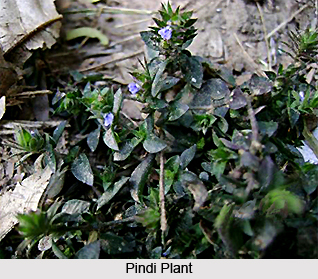 Pindi is a medicinal plant found as a weed throughout the warmer parts of India in grassy pasture lands, and also at an altitude of about 1200 m in the Himalayas. It is also common in the moist habitats along streams in southern parts of India.
Pindi is a medicinal plant found as a weed throughout the warmer parts of India in grassy pasture lands, and also at an altitude of about 1200 m in the Himalayas. It is also common in the moist habitats along streams in southern parts of India.
Naming of Pindi
The major botanical names of this plant are Fusticia Pectinaia and Rungia Parviflora Nees. The common name of this plant varies from place to place. Such as in Sanskrit language it is called as Pindi, Tamil people call it as Punaka-Pundu and Tavasumurungi, whereas it is famous as Mothokhadsalio and Moto Khad-Salyo among Gujarati people.
Characteristic Features of Pindi
It is a branched and erect herb. The shape of the leaves depend on the location of its habitat, such as the plants found in moister habitat possess elliptical-lanceolate or oblong-lanceolate leaves and the plants found in the arid and dry regions bear smaller and ovate or orbicular leaves. The base of the plant Pindi or Rungia Pectinata (L) Nees is acute seems like glabrous. The flowers of these plants are very small, light blue, purple or white in colour. These flowers bear villous bracts, which are arranged prominently. The fruits or capsules are 2.5 cm long and ovoid in shape. Seeds of these fruits are yellow coloured mostly of 2-4 seeded.
Medicinal Uses of Pindi
These plants are used for various medicinal purposes throughout the country. The juice of the leaves is used as cooling and aperient, and is given to children suffering from smallpox. The bruised leaves of the plant are applied as pain reliever and to reduce swelling. Santhali community of Bihar uses its roots as a febrifuge.
This article is a stub. You can enrich by adding more information to it. Send your Write Up to content@indianetzone.com



















